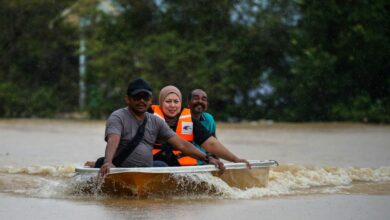With the help of a borrowed travel neck pillow and an effective sleeping pill, I managed to spend most of my plane ride to Malaysia in dreamland. I would open my eyes for brief moments, try to open the window next to me–forgetting the fact that it’s going to be sunny outside–but a male flight attendant with a serious case of attitude would stop me, asking me not to allow the light in.
Nine hours later and I was allowed to open the window next to me. I couldn’t see anything but clouds for an hour or so before I started to notice the land approaching from afar. Slide after slide of green islands started to appear in the gaps between the clouds, then, without further delay, Malaysia appeared.
Closer to the airport, while still in the air, we noticed miles of coconut trees planted all around the city of Kuala Lumpur (or KL, as the locals like to call it). The KL airport, the 13th busiest in the world and the airport globally voted best in 2008 for the 15-25 million passengers category, is built around part of the jungle forest. In the airport's Free Zone section, behind glass windows you can view the jungle replete with waterfalls, towering trees and butterflies.
Leaving the airport gate, a number of transportation methods are presented–from airport taxis, city buses and fast trains– to take you to KL. Easy transportation is one of the highlights of KL in general; everything is reachable and the city in general is easily navigable.
Being the backpacker that I am, I picked a cute little hostel called Equator Hostel in the heart of the city. The hostel, like many places around town, has a sign on the door asking you to take your footwear off–a Malay tradition. The ACed rooms are basic, yet clean, and the manager, a Malay lady with tons of positive attitude, is extremely helpful and friendly.
“You should be extremely early to visit the Petronas Twin Towers,” the manager advised us, giving us a free city map. “They give free visiting tickets in the morning around 7:30, and people gather there hoping to get the tickets.”
We didn't listen to the advice and took a extra couple of hours of sleep, which turned out to be the wrong choice. When we arrived at the Petronas Towers (around 10 AM) the free tickets were gone, and the line for the paid tickets was endless.
Ninety minutes later, we had our promised tickets, but our tour wouldn’t start before 2.20PM, so we decided to have a tour in the “most happening” shopping mall in KL, the Suria KLCC.
We had an amazing meal (Sushi for breakfast, who knew?). But we will return to Malaysian cuisine in future articles. Eating berry muffin and drinking a cup of hot chocolate, I sat in the garden adjacent to the twin towers and the shopping mall, and gazed at the towers, connected in the middle by a bridge. Jutting an impressive 542 meters into the sky, the towers were the highest building in the world between 1998 and 2004. Their height was then surpassed by Taipei 101 in Taiwan. The towers, however, remain the tallest twin buildings in the world.
Children wearing yellow outfits passed by me. I waved to them and they waved back. The trip up to the sky bridge between the towers is a challenge to the ears, as you have the same feeling of pressure as on airplanes, but the minute you arrive in the bridge, the beautiful scenes take your breath away. The tour, highly organized and timed to allow you 25 minutes in the bridge, was worth the wait.
Another highlight of the Malaysian capital is the gardens of KL. As you walk towards the Museum of Islamic Arts, you start to notice the greenery around you, and the jumping monkeys. The further you edge closer to the museum, the more signs advertising the parks of KL there are. The butterflies park (Rama Rama Park) and the birds park are the main attraction, but a hibiscus park is also nearby.
Both the butterflies park and the birds park are covered with huge nets to keep the animals inside the premises, while allowing them the freedom to walk around with visitors. The butterflies park is the home of a huge number of different and amazingly beautiful bug species, mainly butterflies; some locked-up spiders, crabs and scorpions are there as well. Some of the butterflies are surprisingly big, and if you roam the garden for a while one of the big black butterflies might take a rest on your shoulder.
The bird park, which is noticeably bigger than its butterfly counterpart, has many different species of birds roaming around the place and playing (or attacking in a friendly way) the public. You will encounter many animals living in their natural atmosphere, as the park is divided into five different areas, each built to mimic the natural habitat of different groups of bird species.
I had a brief encounter with a peacock, who was protective of his feeding zone, and a huge number of parrots gathered on my shoulders to drink from a glass of coconut juice I had in my hand. But that, as well, is another story.
While our days were filled with towers, monkeys and butterflies, our nights aimed to explore the city's different districts. Our first attraction was Chinatown, which resembled a tuned down version of Khan al-Khalili–less harassment and a wider variety of items. A huge collection of fake brands is available there, and even some of the brandless clothes shops hold an amazing collection of items.
Little India I found it to be underwhelming, but I enjoyed the one in Gorge Town–the capital of Penang–an amazing street for beautiful and elaborate golden items that you would only see in Bollywood movies.
But the best attraction of KL, honestly, is its people. The three identities (Malay, Chinese and Indian) that work together to build this amazing city, create such a lovely and unique cultural cornucopia, rendering each and every corner beautiful in its own right. It’s a city of dreams in a modern world that, sometimes, can be dreamless.




